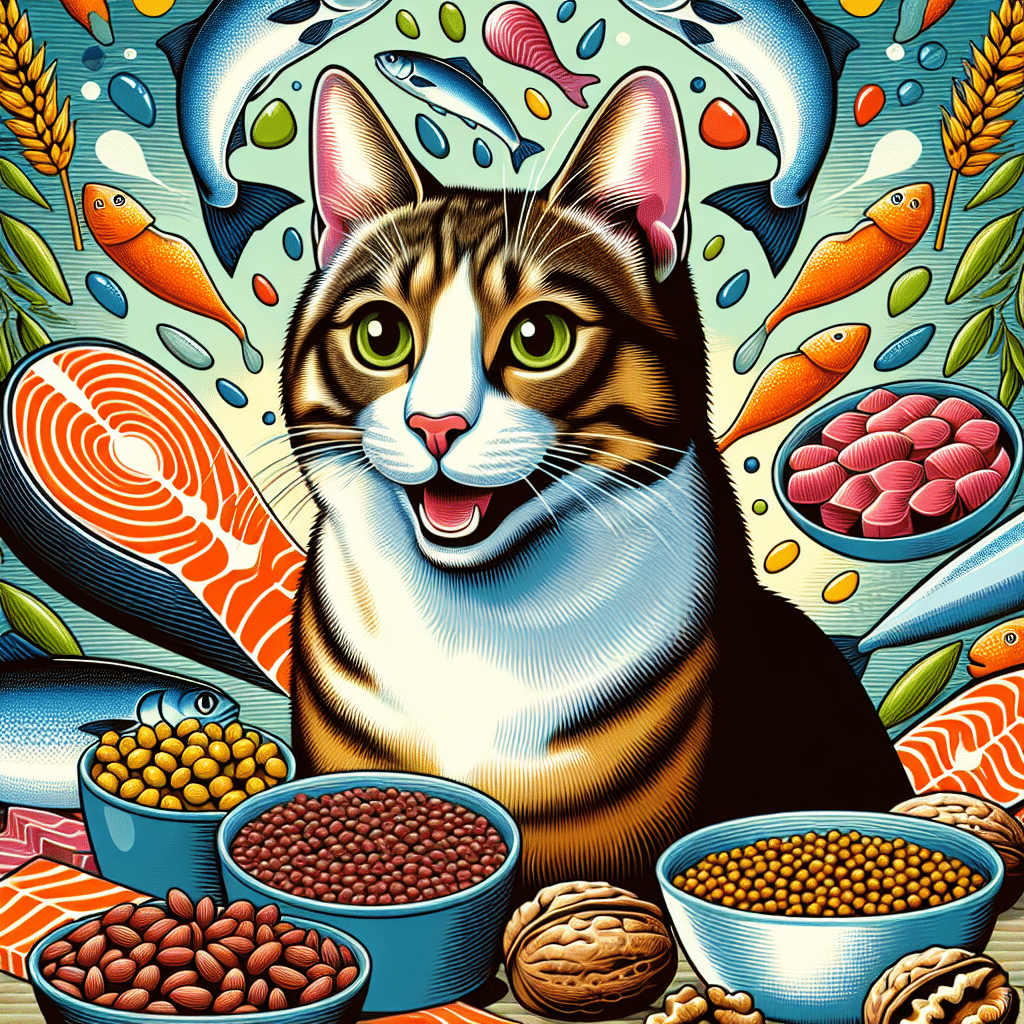Understanding Omega Fatty Acids: Omega-3 and Omega-6
Omega-3 and Omega-6 fatty acids are essential nutrients for cats, playing a crucial role in their overall health. These polyunsaturated fats contribute to various bodily functions, including skin health, coat quality, immune system support, and cognitive function. Unlike dogs, cats cannot produce these fatty acids themselves, making it essential to include them in their diet.
The Benefits of Omega-3 Fatty Acids
-
Skin and Coat Health: Omega-3 fatty acids, notably EPA (eicosapentaenoic acid) and DHA (docosahexaenoic acid), are effective in alleviating dry skin and improving coat shine. They combat inflammation that often leads to skin irritations, allergies, and hotspots.
-
Joint and Heart Health: By reducing inflammation, Omega-3 fatty acids help prevent arthritis and maintain joint function. They support cardiovascular health by improving heart function and potentially lowering blood pressure.
-
Cognitive Function: DHA is especially beneficial for brain development and function. It has been linked to improved cognitive abilities in older cats, helping to stave off cognitive dysfunction syndrome.
-
Anti-Inflammatory Properties: Omega-3 is known for its potent anti-inflammatory effects, making it advantageous for cats with chronic inflammatory conditions and allergies.
The Benefits of Omega-6 Fatty Acids
-
Skin Barrier Function: Omega-6 fatty acids, particularly linoleic acid, are vital for maintaining the skin barrier. A healthy barrier helps keep moisture in and allergens out, reducing the risk of skin disorders.
-
Cellular Health: Omega-6 fatty acids play a key role in cellular function, promoting healthy cell membranes and signaling pathways.
-
Immune System Support: These fatty acids support the immune system by modulating inflammatory responses, enhancing the body’s ability to combat infections.
-
Hormonal Balance: Omega-6 is crucial for the production of eicosanoids, which are hormone-like substances that regulate various physiological responses, including inflammation and the immune response.
Sources of Omega-3 and Omega-6 in Cat Food
Choosing a cat food rich in Omega-3 and Omega-6 fatty acids is vital for optimal health. Here are some of the best sources:
Fish Oils
-
Salmon Oil: Rich in EPA and DHA, salmon oil is one of the most popular supplements for omega fatty acids in cat food. It promotes a shiny coat and healthy skin.
-
Herring and Sardine Oil: These oils are also excellent sources of Omega-3 fatty acids and are often used in premium cat foods.
Plant Oils
-
Flaxseed Oil: A great source of Omega-3 fatty acids, particularly ALA (alpha-linolenic acid). While ALA is not as potent as EPA and DHA, it still provides benefits and is often found in holistic cat foods.
-
Sunflower Oil: Rich in Omega-6 fatty acids, sunflower oil supports skin health and provides energy for active cats.
-
Canola Oil: Another oil high in Omega-6, canola oil is often included in commercial cat food for its nutritional benefits.
Animal Fats
-
Chicken Fat: A common ingredient in many cat foods, chicken fat offers a source of both energy and Omega-6 fatty acids, supporting skin and coat health.
-
Beef Tallow: Another source of Omega-6 fatty acids, beef tallow is less common but found in some monoprotein diets.
Selecting the Right Cat Food
When selecting cat food rich in Omega-3 and Omega-6 fatty acids, consider the following factors:
-
Read the Ingredients List: Look for high-quality animal proteins and oils at the beginning of the list. Ingredients like salmon, herring, or premium fish oils indicate a higher concentration of Omega-3s.
-
Check For Quality Certifications: Opt for brands that are tested for quality and safety. Certifications from organizations like AAFCO (Association of American Feed Control Officials) ensure the food meets specific nutritional guidelines.
-
Avoid Fillers: Avoid foods that list corn, wheat, or soy as primary ingredients. These are often used as fillers and do not provide the essential fatty acids your cat needs.
-
Consider Life Stage and Specific Needs: Tailor your choice based on your cat’s age, activity level, and health conditions. For example, kittens require a diet rich in DHA for proper brain development, while senior cats benefit from more Omega-3 for joint health.
Popular Cat Food Brands Rich in Omega-3 and Omega-6
-
Wellness CORE: This grain-free option features deboned turkey and chicken fat, containing added fish oil for a rich source of Omega-3 and Omega-6 fatty acids.
-
Blue Buffalo Wilderness: High-protein with meat as the first ingredient, it contains fish oil to boost Omega-3 levels while providing balanced nutrition.
-
Hill’s Science Diet: Specifically formulated for various life stages, this brand offers options that include fish oil for enhanced Omega-3 and Omega-6 content.
-
Orijen Cat & Kitten: Known for its biologically appropriate recipes, Orijen includes fresh fish and fish meal, providing a powerful source of Omega fatty acids.
-
Canidae PURE: This limited-ingredient diet emphasizes high-quality animal protein sources along with Omega fatty acids from fish and chicken fat, ideal for cats with sensitivities.
Conclusion
Incorporating cat food rich in Omega-3 and Omega-6 fatty acids leads to a multitude of health benefits. Enhanced skin and coat health, improved joint function, and better cognitive performance are just a few advantages. By understanding the sources and selecting high-quality cat food, you can ensure your feline friend enjoys a healthier and happier life, thriving with the essential nutrients they need. Always consult with your veterinarian to determine the best dietary choices for your specific cat’s needs, particularly if they have existing health conditions. Proper nutrition, including Omega fatty acids, is a cornerstone of feline wellness and longevity.
